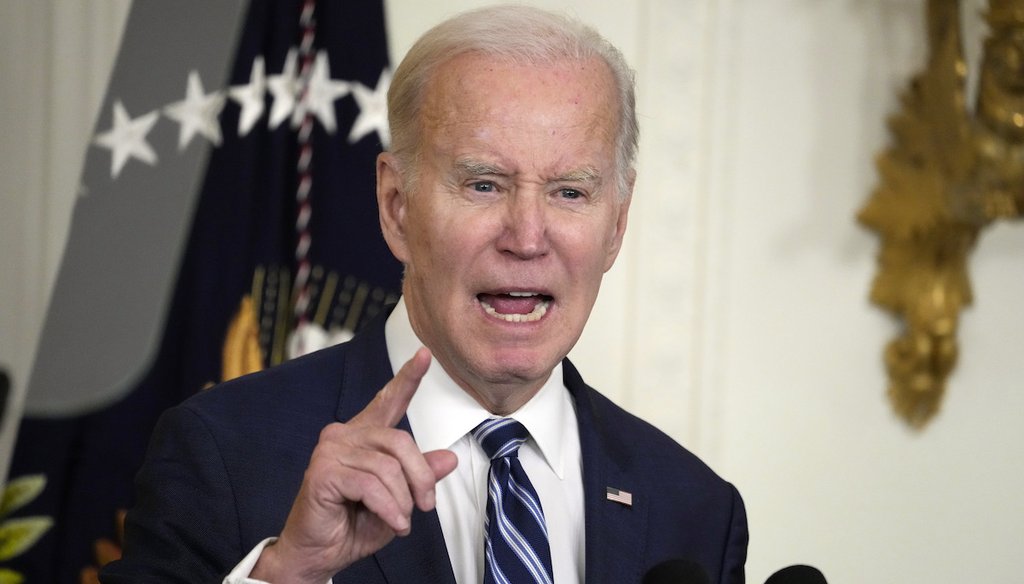Get PolitiFact in your inbox.

President Joe Biden speaks Feb. 27, 2023, at an event to celebrate Black History Month at the White House. (AP)
Biden says expanded child tax credit sharply cut poverty for Black children; data shows he’s right
If Your Time is short
-
Poverty among Black children in the United States dropped nearly half from 2020 to 2021, following the expansion of the child tax credit, according to U.S. Census Bureau supplemental poverty measure data. Data provided by the White House put the drop a little higher, at 52% from 2020 to 2021; it also sourced its information to the U.S. Census Bureau supplemental poverty measure. The reason for the slight difference between the two figures is not clear.
-
Experts said the drop is linked to the child tax credit expansion. When the tax credit expired, the poverty rate rose, Columbia University’s Center on Poverty and Social Policy reported.
-
Despite the progress generated by the tax credit, poverty among Black children remained disproportionately high in 2021 compared with white children.
During Black History Month, President Joe Biden said policy can go a long way toward tackling persistent problems such as Black child poverty.
In a Feb. 27 White House address, Biden said the child tax credit he’d expanded through the American Rescue Plan delivered big results for Black Americans.
"We cut Black child poverty in half in 2021 because of the child tax credit," Biden said. "Look, we need to help make that tax credit permanent now."
When we emailed the White House for Biden’s data source, a spokesperson there pointed us to supplemental poverty numbers from the Census Bureau.
By those numbers, The White House said, Black child poverty fell from 17.2% in 2020 to 8.3% in 2021. That amounts to a 52% drop — what the White House described as "the largest reduction in history" that achieved "by far the lowest rate in history."
The drop from 2019, it said, was 60%.
What is the supplemental poverty measure?
The supplemental poverty measure was introduced in 2011. Its aim was to update what’s known as the "official poverty measure," which was formulated in the 1960s. The official poverty measure is based on cash resources.
The supplemental poverty measure went further. It includes cash and noncash benefits and subtracts necessary expenses — such as taxes and medical expenses — and also accounts for government programs designed to assist low-income families — such as the Supplemental Nutrition Assistance Program — that aren’t included in the official poverty measure.
The supplemental measure is not the official one, but specialists, including some at the Massachusetts Institute of Technology, say it is preferred over the official measure because it goes beyond access to food to offer a more diverse set of data to determine poverty.
Census Bureau numbers show 44.2% decline between 2020 and 2021
Biden’s numbers were not far from supplemental child poverty numbers contained in a Sept. 13 U.S. Census Bureau report that said Black child poverty dropped from 14.5% in 2020 to 8.1% in 2021 — a 44.2% decline. In all, the bureau said, 716,000 Black children were lifted out of poverty.
Overall, the supplemental poverty numbers show poverty among all U.S. children dropped from 9.7% in 2020 to 5.2% in 2021, the bureau said — a decline of 46%. About 5.3 million people were lifted out of poverty, including 2.9 million children.
We contacted the White House to learn why its numbers and the Census Bureau’s release differed. We didn’t hear back.
It’s worth noting that using the official poverty measure, overall child poverty dropped 0.7 percentage points from 16% to 15.3%, the bureau said.
What Biden did
Biden’s American Rescue Plan increased the child tax credit from $2,000 to $3,600 for children younger than 6 and to $3,000 for children 6 to 17. The credit is refundable and is no longer limited by the taxpayer’s income tax liability. Beneficiaries received up to half the credit in monthly payments from July 2021 to December 2021. They included families with very low incomes who are therefore not required to file a tax return.
The provision lapsed after that, facing opposition from Republicans and Sen. Joe Manchin, D-W.Va., who argued that expanding the credit would worsen inflation.
But when the expanded tax credit expired, child poverty spiked, Columbia University’s Center on Poverty and Social Policy reported. In February, the center said, supplemental child poverty rose from 12.1% in December 2021 to 17% in January 2022 — a 41% change. This meant 3.7 million more children were living below the poverty line.
Biden and Sen. Bernie Sanders, I-Vt., predicted in 2021 that expanding the child tax credit could halve U.S. child poverty. Timothy Smeeding, a University of Wisconsin-Madison public policy professor, said the expanded child tax credit worked as forecast.
"This is exactly what should be expected," Smeeding said, adding that the supplemental measure is the best way to measure poverty and mark how much it shrank when the credit expanded.
New School for Social Research economics professor Steven Pressman said the expanded tax credit mirrored policies in other nations, delivered by national governments as "family allowances."
"I cannot think of any better way to reduce child poverty than through a refundable child tax credit," Pressman said. "The policy is so effective because it deals with a problem that the market cannot address. Families with children, and families with more children, have greater income needs (and a higher poverty line) than single families and families with fewer children. However, firms will not pay their workers more money just because they have more mouths to feed at home."
Despite the progress, supplemental Black child poverty rates remained disproportionately high in 2021 at 8%, compared with white children at 3%, according to the Annie E. Casey Foundation, a charitable foundation favoring mainly liberal causes. The rate was also higher for other ethnic minority children — Latino children at 8%), American Indian and Alaska Native children at 7%, and Asian and Pacific Islanders at 6%). The Census Bureau reported drops in Asian and Latino child poverty during the 2021 child tax credit expansion, but had no data for American Indian and Alaska Native children.
In a September 2022 article in the Conversation, a website with articles written by academics and researchers, Pressman and Monmouth University business statistics, econometrics, macroeconomics professor Robert H. Scott III wrote that the child poverty rate could have fallen even further had the government ensured that more eligible families received the expanded child tax credit.
Many low-income families didn’t owe federal income taxes in 2019 or 2020, and therefore didn’t file tax returns for those years, a requirement for getting the monthly tax credit payments in 2021 from the IRS. Even if low-income families filed returns, Pressman and Scott wrote, some may not have accessed the credits from the IRS’ website for reasons that may have included lack of internet access.
Also, Columbia University’s Center on Poverty and Social Policy reported, some Americans lack bank accounts the IRS can access, which complicated the distribution of payments. Those families, the center wrote, "are likely to be among the lowest-income families, disproportionately Black or Latino, and may have … family circumstances that pose challenges for outreach and enrollment, including disabilities, insecure housing, lack of internet or phone access, a language other than English spoken at home, and more."
Biden’s new budget, issued March 9, proposed reinstating the expanded child tax credit at full refundability, which would mean that parents with no income could still receive the full amount. Centrist Democrats and conservative Republicans oppose full refundability, arguing that cash grants would discourage nonworking parents from working.
Our ruling
Biden said, "We cut Black child poverty in half in 2021 because of the child tax credit."
U.S. Census Bureau data shows that poverty among Black children dropped by nearly half from 2020 to 2021, following the expansion of the child tax credit. That figure came from the national supplemental poverty measure, which unlike the official measure, accounts for financial assistance low-income households receive from governmental programs such as SNAP. The White House cited similar numbers.
Experts linked the change to Biden’s child tax credit expansion, pointing to data showing that poverty rates rose once the payments ended. Despite that progress, poverty among Black children remained disproportionately high in 2021 relative to white children — 8% compared with 3%, respectively.
Because there are two ways to measure poverty and Biden used only one, his statement is accurate, but needs clarification. We rate this claim Mostly True.
Our Sources
The New York Times, A poverty line that's out of date and out of favor, March 12, 2006
Pew Research Center, Prior to COVID-19, child poverty rates had reached record lows in U.S., Nov. 30, 2020
PoliitFact, Bernie Sanders claim that childhood poverty is cut in half is premature, Sept. 15, 2021
PoltiFact, Joe Biden’s plan to cut child poverty by half: What you need to know, Feb. 25, 2021
Urban Institute, How a permanent expansion of the child tax credit could affect poverty, July 2021
PolitiFact, Raphael Warnock exaggerates success rate for reaching child tax credit recipients, Sept. 2, 2022
The Conversation, Child poverty fell to a record-low 5.2% in 2021 – here’s how it could have been even lower, Sept. 13, 2022
Annie E. Casey Foundation, The ultimate tradeoff: Healthy children or draconian attempts to rein inflation, Nov. 16, 2022
CNN, The child poverty rate fell by nearly half in 2021 as enhanced child tax credit sent billions of dollars to families, March 10, 2023
CNBC, Biden’s budget pushes to renew bigger child tax credit payments for families, March 10, 2023
Insider, The IRS’ child tax credit portal 'looks like crap and it's not really usable' for low-income Americans trying to get $300 monthly federal payments, June 29, 2021
The American Prospect, The poor aren’t getting the help Democrats want to give them, July 23, 2021
Brookings Institution, The antipoverty effects of the expanded Child Tax Credit across states: Where were the historic reductions felt?, March 1, 2023
Annie E. Casey Foundation, New data show that the child tax credit fueled a substantial reduction in child poverty, Sept. 19, 2022
Center on Budget and Policy Priorities, Policymakers should expand child tax credit in year-end legislation to fight child poverty, Oct. 20, 2022
NPQ, Ending child poverty: Lessons from a one-year expansion of the child tax credit, Jan. 18, 2023
White House fact sheet, President Biden’s budget lowers costs for families and gives the American people more breathing room, March 9. 2023
U.S. Census Bureau, Supplemental poverty measure, accessed March 13, 2023
U.S. Census Bureau, The impact of the 2021 expanded Child Tax Credit on child poverty, Table 3, accessed March 14, 2023
University of Wisconsin-Madison, How is poverty measured?, accessed March 13, 2023
Internal Revenue Service, Advance child tax credit payments in 2021, accessed March 12, 2023
Email exchange, the White House, March 12, 2023
Email interview, Timothy Smeeding, public policy professor, University of Wisconsin-Madison, March 13, 2023
Email interview, Steven Pressman, economics professor, New School for Social Research, March 15, 2023
Browse the Truth-O-Meter
More by Matthew Crowley
Biden says expanded child tax credit sharply cut poverty for Black children; data shows he’s right
Support independent fact-checking.
Become a member!
In a world of wild talk and fake news, help us stand up for the facts.












































